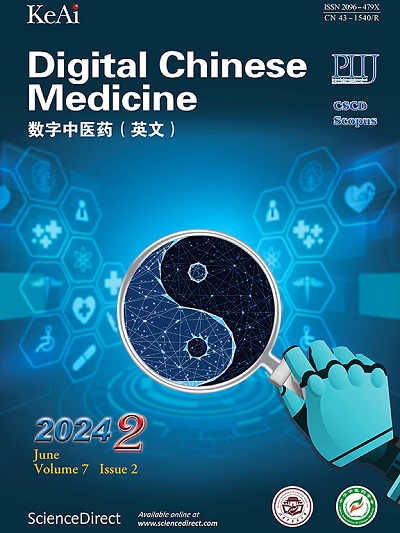电针治疗骶上脊髓损伤后逼尿肌-膀胱颈协同障碍的蛋白质组学机制
Q3 Medicine
引用次数: 0
摘要
目的探讨电针(EA)治疗骶上脊髓损伤(SSCI)后逼尿肌-膀胱颈协同障碍(DBND)的可能机制。方法选取SPF级雌性SD大鼠52只(10 ~ 12周龄,250 ~ 280 g),随机分为假手术组(n = 12)和脊髓损伤模型组(n = 40)。模型组采用T10水平Hassan Shaker脊髓横断诱导DBND,符合纳入标准的24只大鼠随机分为DBND组(n = 12)和EA干预组(DBND + EA组,n = 12)。脊髓休克恢复后(造模后第19天),DBND + EA组在Ciliao (BL32)、Zhongji (RN3)、Sanyinjiao (SP6)穴位进行10/50 Hz频率的EA治疗,每次20 min,每日1次,连续10 d。Sham组和DBND组仅麻醉,不进行EA干预。造模后第29天,所有大鼠进行尿动力学评估,随后进行苏木精和伊红(HE)染色、tandem mass tag (TMT)蛋白质组学和逼尿肌和膀胱颈部组织的Western blot (WB)分析。差异表达蛋白(DEPs)被定义为含有P和lt的蛋白;0.05,独特肽≥2,折叠变化>;1.2或<;0.83. 京都基因与基因组百科全书(KEGG)通路分析采用KOBAS 3.0 (P <;使用Search Tool for Retrieval of Interacting Genes/Proteins (STRING) 11.5和Cytoscape 3.9.1分析蛋白质-蛋白质相互作用(PPI)网络。结果与假手术组比较,DBND组渗漏点压力(LPP)和最大膀胱容量(MCC)均显著升高(P <;0.01)。与DBND组相比,EA治疗显著降低LPP和MCC (P <;0.01和P <;分别为0.05)。HE染色显示,EA减轻了逼尿肌纤维化,改善了膀胱颈炎症。与假手术组比较,dnd + EA/DBND组在逼尿肌发现30个重叠dep,膀胱颈部发现59个重叠dep。在逼尿肌组织中,KEGG分析显示了10条显著富集的通路(P <;0.01),包括丝裂原活化蛋白激酶(MAPK)信号通路。PPI分析显示,30例dep中有22例相互关联。在膀胱颈部组织中,14条通路显著富集(P <;0.01),包括松弛素信号通路,59个dep中有51个显示相互连接。TMT和WB验证表明,与假对照组相比,DBND大鼠在逼尿肌组织中表现出ⅳ型胶原α 2链(Col4a2)上调和鸟嘌呤核苷酸结合蛋白G(z)亚基α (Gnaz)下调,而EA治疗使这两种蛋白(P <;0.05)。在膀胱颈部组织中,DBND大鼠与假对照组相比,平滑素(Smtn)和钙活化钾通道亚基β -1 (Kcnmb1)的表达降低(P <;0.01), EA治疗后两者均上调(P <;0.01和P <;分别为0.05)。结论ea通过双靶点机制恢复DBND患者逼尿肌-膀胱颈协调功能。在逼尿肌组织中,EA通过细胞外基质重塑、环磷酸腺苷(cAMP)信号通路调节和神经递质介导的三磷酸腺苷(ATP)生物合成增强来调节收缩。在膀胱颈部组织中,EA通过维持收缩表型、减少纤维化、抑制平滑肌兴奋和调节突触前神经递质释放来促进松弛。这些发现为EA在治疗DBND中的作用提供了机制上的见解。本文章由计算机程序翻译,如有差异,请以英文原文为准。
Mechanism of electroacupuncture treating detrusor-bladder neck dyssynergia after suprasacral spinal cord injury by proteomics
Objectives
To elucidate the potential mechanisms of electroacupuncture (EA) in restoring detrusor-bladder neck dyssynergia (DBND) following suprasacral spinal cord injury (SSCI).
Methods
A total of 52 specific pathogen-free (SPF) grade famale Sprague-Dawley (SD) rats (10 – 12 weeks, 250 – 280 g) were randomly assigned to either a sham group (n = 12) or a spinal cord injury model group (n = 40). In the model group, DBND was induced through Hassan Shaker spinal cord transection at T10 level, with 24 rats meeting inclusion criteria and subsequently randomized into DBND group (n = 12) and EA intervention group (DBND + EA group, n = 12). After spinal shock recovery (day 19 after modeling), DBND + EA group received EA treatment at Ciliao (BL32), Zhongji (RN3), and Sanyinjiao (SP6) acupoints for 20 min per session at 10/50 Hz frequencies, once daily for 10 d. Sham and DBND groups received anesthesia only without EA intervention. On day 29 post-modeling, all rats underwent urodynamic assessments, followed by hematoxylin and eosin (HE) staining, tandem mass tag (TMT) proteomics, and Western blot (WB) analysis of detrusor and bladder neck tissues. Differentially expressed proteins (DEPs) were defined as proteins with P < 0.05, unique peptides ≥ 2, and fold change > 1.2 or < 0.83. Kyoto Encyclopedia of Genes and Genomes (KEGG) pathway analysis was performed using KOBAS 3.0 (P < 0.01), and protein-protein interaction (PPI) networks were analyzed using Search Tool for the Retrieval of Interacting Genes/Proteins (STRING) 11.5 and Cytoscape 3.9.1.
Results
Compared with sham group, DBND group showed significantly elevated leak point pressure (LPP) and maximum cystometric capacity (MCC) (both P < 0.01). EA treatment significantly reduced both LPP and MCC compared with DBND group (P < 0.01 and P < 0.05, respectively). HE staining revealed that EA reduced detrusor fibrosis and improved bladder neck inflammation. TMT proteomics identified 30 overlapping DEPs in detrusor and 59 overlapping DEPs in bladder neck when comparing DBND + EA/DBND groups with sham group. In detrusor tissue, KEGG analysis revealed 10 significantly enriched pathways (P < 0.01), including mitogen-activated protein kinase (MAPK) signaling pathway. PPI analysis showed 22 of 30 DEPs were interconnected. In bladder neck tissue, 14 pathways were significantly enriched (P < 0.01), including relaxin signaling pathway, with 51 of 59 DEPs showing interconnections. Both TMT and WB validations demonstrated that compared with sham controls, DBND rats exhibited upregulated collagen type IV alpha 2 chain (Col4a2) and downregulated guanine nucleotide-binding protein G(z) subunit alpha (Gnaz) in detrusor tissue, while EA treatment normalized both proteins (both P < 0.05). In bladder neck tissue, DBND rats showed decreased expression of smoothelin (Smtn) and calcium-activated potassium channel subunit beta-1 (Kcnmb1) compared with sham controls (both P < 0.01), which were both upregulated following EA treatment (P < 0.01 and P < 0.05, respectively).
Conclusion
EA restores detrusor-bladder neck coordination in DBND through dual-target mechanisms. In detrusor tissue, EA modulates contraction via extracellular matrix remodeling, cyclic adenosine monophosphate (cAMP) signaling pathway regulation, and enhanced adenosine triphosphate (ATP) biosynthesis mediated by neurotransmitters. In bladder neck tissue, EA promotes relaxation by maintaining contractile phenotypes, reducing fibrosis, suppressing smooth muscle excitation, and regulating presynaptic neurotransmitter release. These findings provide mechanistic insights into EA's therapeutic role in managing DBND.
求助全文
通过发布文献求助,成功后即可免费获取论文全文。
去求助
来源期刊

Digital Chinese Medicine
Medicine-Complementary and Alternative Medicine
CiteScore
1.80
自引率
0.00%
发文量
126
审稿时长
63 days
期刊介绍:
 求助内容:
求助内容: 应助结果提醒方式:
应助结果提醒方式:


